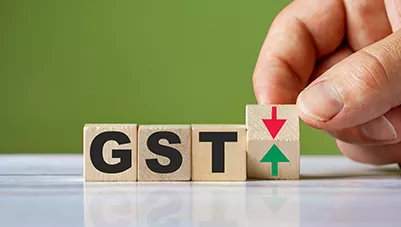The full form of GST is “Goods and Services Tax”. GST is a comprehensive indirect tax introduced in India on 1st July 2017, replacing the previous multiple indirect taxes such as excise duty, service tax, VAT, and others.
GST is a destination-based tax levied on the supply of goods and services. In India, It is a value-added tax that is collected on the value added at each stage of production or distribution, with credit allowed for any tax paid on purchases made for business purposes. GST aims to create a simplified, single tax system that eliminates the cascading effect of multiple taxes and promotes ease of business in India.

What is meant by direct tax?
Direct Tax is imposed on the income of an assessee (individual or company or firm or HUF or any other person).
The amount of tax payable varies on the income earned by the individual from various sources such as salary, house rent income, Bank FD interest, etc. So, the more you earn, the more tax you pay to the Government which essentially means the rich pay more tax in comparison to the poor.
Hence, the tax incidence falls on the single person or the assessee and such incidence or tax-paying responsibility cannot be passed onto any other person.
The following is a list of direct taxes relevant in India:
- Income Tax
- Wealth Tax (Abolished and revoked later)
- Estate Tax
What is meant by indirect tax?
Indirect tax is not imposed directly on the income of the persons, as mentioned above. Instead, it is imposed on goods and services transacted which, in turn, increases the cost or MRP of those goods and services.
Unlike a direct tax, indirect tax should be borne by the end customer, rich and poor are treated alike.
There are many indirect taxes. Some of these are levied by the Central Government whereas some are levied by the State Government making the indirect tax system an extremely complicated system.
The following is the list of indirect taxes, currently in India:
- Goods and Services Tax (GST)
- Customs duty
- Excise duty (on Petrol, diesel, natural gas, alcohol)
- Central Sales Tax (relevant for certain goods only)
- Securities Transaction Tax (STT)
- Stamp Duty
- Entertainment Tax
GST was introduced to replace multiple indirect taxes levied by State and Central Governments in order to simplify the indirect tax system. It has replaced almost 17 of the existing state and central indirect taxes such as central excise duty, additional customs duty, VAT, entertainment tax, service tax etc.
Why was GST introduced in India?
GST, or Goods and Services Tax, was introduced in India to create a single, comprehensive indirect tax system to replace the complex and multi-layered indirect tax structure that existed earlier.
The following were the main reasons for introducing GST in India:
- To eliminate the cascading effect of taxes: Under the previous tax regime, taxes were levied on top of taxes, resulting in a cascading effect that increased the cost of goods and services. GST, with its seamless credit mechanism, eliminates this cascading effect, making goods and services more affordable.
- To simplify the tax structure: The previous tax regime had a complex and multi-layered tax structure that was difficult to understand and comply with. GST, with its simplified tax structure, reduces the compliance burden for businesses and makes it easier for them to understand and pay taxes.
- To promote ease of doing business: The introduction of GST has made it easier for businesses to operate across different states in India. Under the previous tax regime, businesses had to comply with different tax laws in different states, which increased their compliance burden. GST has created a uniform tax regime across India, making it easier for businesses to operate.
- To boost economic growth: GST is expected to boost economic growth by enhancing tax compliance, reducing tax evasion, and promoting the formalization of the economy. It is also expected to increase tax revenue for the government, which can be used for infrastructure development and other social welfare initiatives.
GST meaning in various Indian languages
| GST meaning in Arabic | ضريبة السلع والخدمات |
| GST meaning in Bengali | পণ্য ও পরিষেবা কর |
| GST meaning in English | Goods and Services Tax |
| GST meaning in Gujarathi | સામાન અને સેવાઓ કર |
| GST meaning in Hindi | वस्तु एवं सेवा कर |
| GST meaning in Kannada | ಸರಕು ಮತ್ತು ಸೇ ವಾ ತೆರಿಗೆ |
| GST meaning in Malayalam | വസ്തുക്കളും സേവന നികുതിയും |
| GST meaning in Marathi | वस्तू आणि सेवा कर |
| GST meaning in Nepali | सामान र सेवा कर |
| GST meaning in Punjabi | ਗੁਡਸ ਐਂਡ ਸਰਵਿਸਿਜ਼ ਟੈਕਸ |
| GST meaning in Sindhi | سامان ۽ خدمتون ٽيڪس |
| GST meaning in Tamil | பொருட்கள் மற்றும் சேவைகள் வரி |
| GST meaning in Telugu | వస్తువులు మరియు సేవల పన్ను |
| GST meaning in Urdu | سامان اور خدمات ٹیکس |
FAQs
What Are the Benefits of the GST?
The GST can be beneficial as it simplifies taxation, reducing several different taxes into one straightforward system. It also is thought to cut down on tax avoidance among businesses and reduces corruption.
Are VAT and GST the Same?
Value-added tax (VAT) and goods and services tax (GST) are similar taxes that are levied on the sale of goods and services. Both VAT and GST are also indirect taxes, which means that they are collected by businesses and then passed on to the government as part of the price of the goods or services.
However, there are some key differences between the two. VAT is primarily used in European countries and is collected at each stage of the production and distribution process, while GST is used in countries around the world and is collected only at the final point of sale to the consumer. VAT is generally applied to a wider range of goods and services than GST, and the rates of VAT and GST can vary depending on the type of goods or services being sold and the country in which they are sold.
